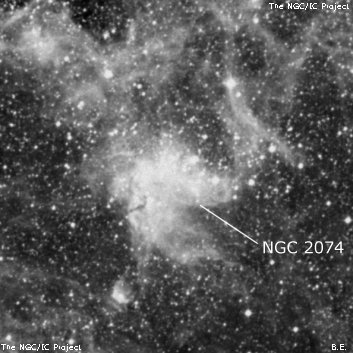
NGC 2074 is part of a huge Superbubble complex (LMC-N158) stretching 11' SW-NE with NGC 2081, a bright HII region that lies just 8' NE. LMC-N158 is located roughly 20' SSE of the center of the Tarantula Nebula.
John Herschel discovered NGC 2074 = h2942 in 1834-1835 (exact sweep or date unknown as based on a detailed sketch of the Tarantula Nebula (NGC 2070) region made over several nights in Nov 1834 and Dec 1835) and recorded as "pL, pB, mE, of irreg rounded and somewhat serpentine figure, much brighter in its foll part; elongated generally in parallel. Involves 5 stars, 2 of which are 10th mag. See Notes in 'First Approximation Towards a Catalogue of Objects in the Magellanic Clouds...'." His position is ~1' W of center.
600/800mm - 24" (4/10/08 - Magellan Observatory, Australia): this prominent HII region (LMC-N158C) and cluster (OB-association LH 101) appeared as a very bright, very large "C" shaped nebula surrounding a semi-circular chain or crown of stars open to the SW. Two bright mag 10.4 and 11 stars oriented SW-NE (50" separation) lie on the northwest end of this crown. The northeastern luminary consists of a 1.8" pair of OB-stars (TDS 3273 = 11.4/11.8) and a mag 12.5 Wolf-Rayet star just 3" W. The mag 11 star to its southwest (HD 269923) is the brightest single star (A0-class) in the cluster. In addtion, a mag 12.5 star (O3-class supergiant) is situated on southeast end of the chain. A bright knot of diameter ~35" is superimposed on the general glow within the northeast side of the "C". At 216x at least 20 fainter stars were resolved in the chain besides the brighter stars at the ends.
Notes by Steve Gottlieb